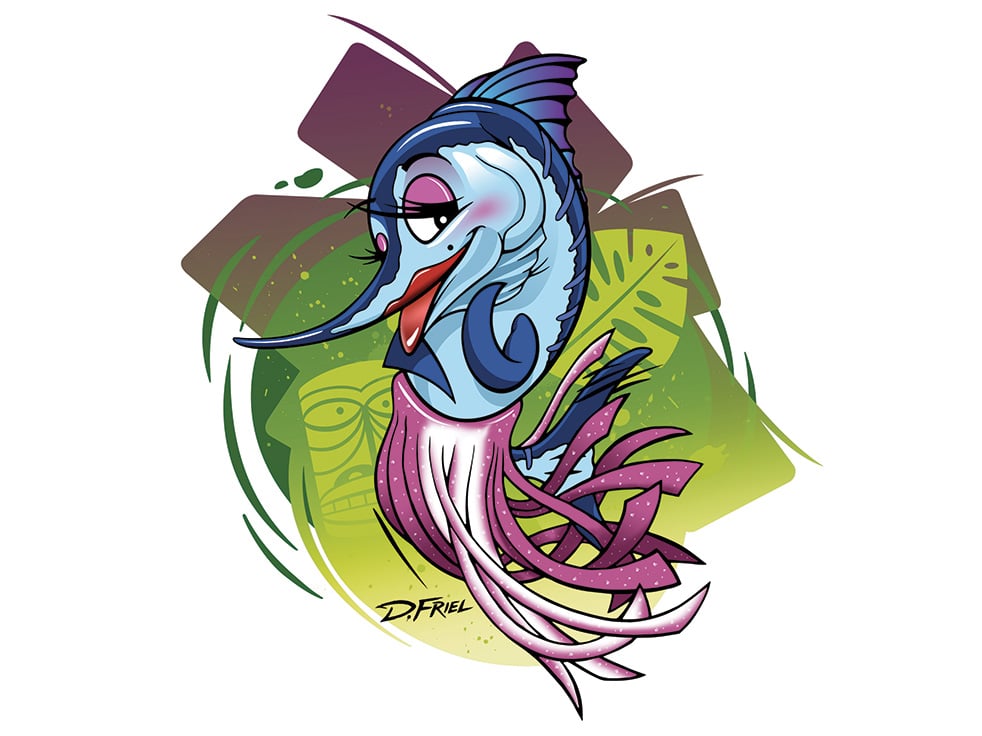
I have been lucky enough to fish on quite a few boats that were marlin fishing, and most used a similar spread: two lures or ballyhoo with chugger heads on the long riggers and two cockpit teasers on the short riggers. Then came two bridge teasers, with a pair of dredges fished closest to the boat.
When I hear crews say that they had a marlin follow a teaser all the way to the boat but they could not get the fish to eat a bait, it might be that the fish lost interest, staring up at the teaser hanging from the rigger. Or even worse, it was a going-away bite, which can be real trouble for the angler, with a good chance of a backlash or a bad hook-set (although it’s a great bite for fly-fishermen).
When we started using the switch-baiting technique for world records, I would slow the boat a bit so the lure was coming in at the same speed we were moving when we raised the billfish. That gave us a better presentation with our pitch bait. I have seen captains who prefer to go into a turn, while others continue at the same speed and with the autopilot on so they remain in a straight line, and it all seems to work just fine. The only problem I see is that crews are having a harder time making the teaser disappear, so the marlin or sailfish sees only the angler’s bait instead.
When a fish comes up on the teaser, the mate pushes the buttons on the dredge reel to get the dredge out of the way, while someone starts retrieving the teaser with the fish behind it — whether it is the cockpit or the bridge teaser. As the teaser comes in, the angler can either pick up a rod that’s already in the spread or pitch a bait from the cockpit. By pitching a bait, the angler keeps it ahead of the teaser so the switch can be made as the teaser moves past the hook bait.
The teaser person waits until they see the bait close to the teaser, then they jerk the teaser away; the only thing the billfish now sees is the angler’s bait. The switch is on.
But these days, most crews are using electric reels for their teasers, and with their slower rate of retrieve, the fish follows the teaser all the way to the boat. Now the crew is yelling at the angler to get the bait up to the boat while the marlin is under the outrigger, staring at a lure hanging just above the surface. Switch-baiting has turned into what I now call “push and follow.” You can tell the top captains who hand-line the bridge teaser because they have scars on their hands from trying to yank away a teaser from a pissed-off blue marlin and the fish rips it out of their hands — 300-pound mono leaves a burn mark across the back of your hand — but they make the switch and get the job done. It’s dangerous, but it is effective for getting the lure away from an aggressive blue marlin.
The other problem is that most teasers are now so long and heavy, with multiple squid and a bait at the end. There is no way to jerk this rig completely out of the way. It is just too heavy, and when it does get to the boat, the last bait is still hanging in the water with a billfish lunging at it. The same thing with some of those big teaser lures that are out there: It is hard to make them jump or disappear out of the marlin’s range of vision so it sees only the angler’s bait. Bigger is not necessarily better in this case.
I have had many billfish follow a lure to the boat, ignoring a beautiful swimming mackerel, a live tuna or anything else we threw at them.
I have had many billfish follow a lure to the boat, ignoring a beautiful swimming mackerel, a live tuna or anything else we threw at them. The fish was fixated on that lure, like a cat chasing a lizard: Take away the lizard, and the cat wants nothing else. For this reason, try to match your pitch baits and teasers in some way. Some days they will eat anything you throw at them. Some days they won’t.
Switch-baiting will give you an incredible view of a billfish bite right off the transom, and it tests your skills as an angler, dropping back to that aggressive marlin or sailfish. It also gives you about the best hookup ratio you can have.







